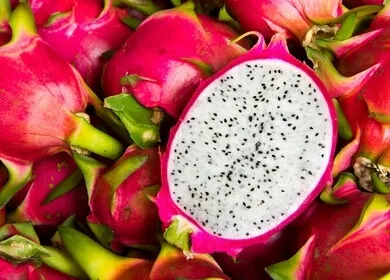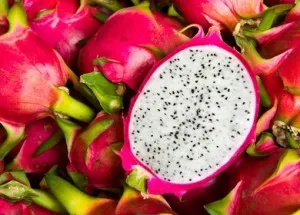
- Share on Facebook162
- Share on Pinterest
- Share on Twitter
With so much talk about superfoods these days, you may be familiar with a number of herbs, nuts, fruits and vegetables, and may have even heard a little about such things as seaweed and bee pollen.
Indeed, these are all awesome and have a plethora of health promoting ingredients, but they are not the end of the list.
There are many strange and almost scary looking fruits that are native to other parts of the world with superfood qualities worth considering, especially when it comes to their ability to protect against one of America’s top killers: cancer.
You may have to look a little harder for these exotic beauties at your grocer or market, but they are starting to become more popular in America as people come to realize their amazing taste and health promoting potential.
Here are three strange, but super, fruits that anyone seeking a tasty treat and an exotic adventure should try.
Cherimoya
Cherimoya (Annona cheirimola) has made its way to Southern California from southern Ecuador and is now produced in limited amounts. It is a well-known fruit in parts of Asia and South and Central America where it grows on evergreen shrubs or small trees.
At first glance, this fruit, fondly known by some as ” ice cream fruit”, looks like some sort of ancient dinosaur egg with its roundish shape and darkened nodules, but don’t let this fool you. Inside is an abundance of health promoting nutrients you don’t want to miss.
Cherimoya fruit contains a high amount of vitamin C, which is a powerful antioxidant that boosts immunity and keeps inflammation at bay. Since the root of much illness and disease, including cancer, can be traced to inflammation, this fruit has much to offer.
Like its cousin graviola, this tropical fruit is loaded with fatty acids including linoleic, oleic, palmitic, stearic and arachidic. The body requires fatty acids from food for a number of functions because we cannot make them on our own.
Brigham Young University Department of Microbiology and Molecular Biology has identified large amounts of antioxidants in all parts of this fruit, especially the juice. Cancer cells are formed due to oxidative stress from free radicals and antioxidants help to neutralize this effect. In addition, cherimoya is high in fiber which helps cleanse the liver and colon from toxins that promote cancer of the liver and colon. The dietary fiber content also protects cardiovascular health.
Rich in B6, which improves brain function, potassium which helps regulate blood pressure and calcium which improves bone health, cherimoya fruit packs a lot of nutritional power in just one bite. Other noted medicinal uses for this super fruit include treatment of anemia, arthritis, stomach cramps, diabetes and parasitic disorders.
Cherimoya even caught the attention of noted author Mark Twain who called it “deliciousness itself.” Author of Living Cuisine: The Art and Spirit of Raw Food, Renée Loux Underkoffler said the cherimoya fruit tastes like a super sweet combination of vanilla, pineapple, coconut and mango all wrapped up in one neat package.
Beware of the seeds, however, they are poisonous and should not be eaten. The best way to enjoy this amazing fruit is to wait until it is ripe and cut it in half and scoop out the flesh. Eat it raw or enjoy it blended in a super delicious and healthy smoothie.
Dragonfruit
Dragonfruit (Hylocereus undatus) is a gorgeous pink fruit with an even prettier inside, grown in Southeast Asia, Central and South America, Israel and Mexico. Dragonfruit is actually a type of cactus and comes in 3 vibrant colors. Two have pink skin; one has white flesh, one has red flesh and another has yellow skin with white flesh.
Dragonfruit is as tasty as it is beautiful and has a sweet and crunchy flavor that falls somewhere between a kiwi and a pear. This exotic delight has only 60 calories per 100 grams. It is both filling and delicious with only 18 calories from fat, 8 from protein and 34 from carbohydrates. However, the carbohydrates are easily broken down by the body into a useable energy form.
Unlike the seeds of the cherimoya, which should not be eaten, dragonfruit contains tiny black seeds that are rich in omega-3 and omega-6 fatty acids. Research indicates that these fatty acids can reduce triglycerides and decrease the risk of cardiovascular disorders. The fiber in this fruit will keep you regular, improve digestive health and help you manage your weight.
If you consume dragonfruit on a regular basis, you will also benefit from its vitamin C, phosphorus, calcium and antioxidants. Rich in B1, B2 and B3, dragonfruit assists with carbohydrate metabolism, reduces bad cholesterol and promotes healthy skin. Minerals in dragonfruit support strong bones and teeth and the phosphorus in it is essential for tissue formation and healthy blood.
Dragonfruit contains phytoalbumins, which have powerful antioxidant properties that help prevent the formation of cancer cells and increase detoxification of heavy metals.
Lycopene gives this fruit its rich color, and according to the National Cancer Institute, may protect against certain cancers. Results from animal studies have shown that lycopene may have chemopreventive effects for prostate, breast, lung, liver and skin cancer.
Scoop out the flesh and enjoy it raw, mixed with other fruits or in a tasty smoothie.
Cupuaçu
Cupuaçu (Theobroma grandiflorum) is a fragrant fruit with a chocolatey pineapple flavor that is found deep in the heart of the Amazon basin, where natives have used it as a main source of food for centuries. Heralded by some as the next grand “superfruit,” this melon-like fruit has thick, buttery flesh that is also used to make a hydrating lotion for skin.
In the Amazon rainforest this fruit is known as ” the pharmacy in fruit.” It is a cousin of the cacao and is prized for it unique combination of flavors that some describe as a mixture of passion fruit, pineapple, bananas, pear and chocolate.
Cupuaçu has an amazing nutritional profile with an impressive collection of nutrients including 9 flavonoids, theracrines and polyphenols. Cacao contains xanthines (caffeine, theobromine and theophylline) while cupuaçu contains theracines which produce similar mood and energy boosting effects without any negative side effects. Other synergistic benefits include lowered cholesterol, clear skin, improved libido and gastro-intestinal system functioning.
 Rich in vitamins B1, B2, B3 and fatty and amino acids, along with 9 protective antioxidants including vitamin C and A, this amazing fruit also contains selenium, calcium and other health promoting minerals. But, it is the fruit’s amazing antioxidant power that has put it in the spotlight as the next #1 superfruit to look out for.
Rich in vitamins B1, B2, B3 and fatty and amino acids, along with 9 protective antioxidants including vitamin C and A, this amazing fruit also contains selenium, calcium and other health promoting minerals. But, it is the fruit’s amazing antioxidant power that has put it in the spotlight as the next #1 superfruit to look out for.
Although this fruit is difficult to find, farms in Brazil are setting up to start importing more of this amazing food into America. Pulp can be made into ice cream, used in smoothies, jams or mousse, and it makes a healthy alternative to processed dessert foods.
We spend a great deal of time and money in this country seeking out alternative energy sources; why not spend some effort seeking out alternative food choices that will nourish our bodies and fight disease? Add these 3 fruits to your list and we will keep on looking!
-The Alternative Daily
Sources:
http://www.cherimoya.com/index.php4?URL=description/classification.php4
http://www.livestrong.com/article/458694-the-benefits-of-cherimoya/
http://www.hort.purdue.edu/newcrop/morton/cherimoya.html
http://www.huffingtonpost.com/2013/02/27/star-fruit-starfruit-carambola_n_2768611.html
http://healthland.time.com/2013/01/10/in-search-of-the-superfruit/
http://www.mnn.com/food/healthy-eating/photos/15-fruits-youve-probably-never-heard-of/cherimoya
http://www.cancer.gov/cancertopics/pdq/cam/prostatesupplements/healthprofessional/page3
https://www.amafruits.com/cupuacu
- Share on Facebook162
- Share on Pinterest
- Share on Twitter

